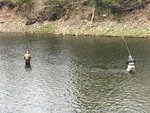It seems as though the weather has continuously been a challenge over the past few weeks - with blustery winds and snow on Saturday keeping all but the most hardy (foolhardy?) from fishing.
As …
This item is available in full to subscribers.
Please log in to continue |


It seems as though the weather has continuously been a challenge over the past few weeks - with blustery winds and snow on Saturday keeping all but the most hardy (foolhardy?) from fishing.
As of Sunday morning, May 10, the Beaverkill at Cooks Falls was flowing at 725 cubic feet per second, which is above the average flow of 653 cfs over 105 years of record-keeping; water temperatures were a cool 40 degrees Fahrenheit.
We fished on Thursday evening until the chilly rains and wind drove us off the river - fishing that afternoon in the warmth of the sun would have been more comfortable. When we arrived at the river the air temperature was 51 degrees F and water temperature was barely 50 degrees. We each caught fish on an Elk Hair Caddis; and observed what appeared to be the Shad Fly heading upstream.
Traveling along the Willowemoc, lower Beaverkill and East Branch Delaware on Friday we noticed the Shadbush (also known as June berry for the tasty berries that come forth in that month) blossoming along the rivers - a favorite, with its delicate white, brown and reddish-colored blooms that are reminiscent of a tea garden planting.
The flowering of this shrub coincides with the American Shad run up the Delaware River, usually in early May; and it is also around this time that the Shad Fly, a caddisfly named for the same reason, makes its appearance.
Caddis flies have tent-shaped wings, segmented bodies and no tails; with their antennae, they look similar to a small moth. The Shad Fly hatch is much-anticipated, as it can be an extremely prolific hatch that will encourage trout to rise and feed heavily. The green egg sacs are an identifier of this fly; in good hatches you'll see car windshields and grilles plastered with hundreds of shadflies.
Driving up to Hendrickson's pool at about midday we noticed a Beaverkill angler with a fish on - and by the time I got out of the car and over to the side of the road he had his fish, a nice sized trout of probably better than 16 inches, in his net. He proceeded to tuck his fly rod under his chin and I realized he was going to take a photo of the fish in his net.
Not wanting to disturb him, I waited until he had put his phone safely back into his wader pocket before congratulating him on a nice trout and asking what he caught it on. “Stonefly nymph!” he replied.
We traveled on to the lower Willowemoc and saw a couple of anglers in the pool below Hazel bridge - also fishing with nymphs, one with a strike indicator on his leader. (A strike indicator is a float - actually a type of bobber- that some people use while fishing nymphs. It assists the fly fisher in determining when a fish takes the nymph below the surface.)
Of the three main types of insects found on trout streams (Mayflies, Caddisflies and Stoneflies) Stoneflies are the largest of the flies. They have two tails and antennae, six legs, and as adults, two pair of wings - the hindwings are shorter than the forewings and fold like a fan, flat over their backs when not in use - very different from the tent-shaped wings of caddisflies or the upright sail-type wings of the mayfly. The first stage of a stonefly's life is the larval stage, when they are commonly referred to as stonefly nymphs; it is spent entirely beneath the surface of the water, and interestingly, the stonefly nymphs' large, powerful legs allow it to cling to its rocky environment for up to three years before it hatches into a winged adult.
Unlike many other aquatic insects, stoneflies do not hatch under or on top of the water; they crawl onto the land - sand, logs or rocks (thus the name stonefly) where they undergo their final molt into the winged adult stage.
Here's a pattern for the Early Brown Stonefly as described in Ernest Schwiebert's book Matching The Hatch:
Early Brown Stonefly
Wing cases: grey goose primary section formed into two cases
Legs: dark bluish grey hen hackle
Thorax: rabbit fur mixed with beaver
Abdomen: beaver, rabbit and brown dyed seal dubbing
Ribbing: dark brown cotton
Tails: two pheasant tail fibers
Silk: brown
Judy Van Put is a long-time member of the NYS Outdoor Writers Association, and is the recipient of the New York State Council of Trout Unlimited's Professional Communications Award.
Comments
No comments on this item Please log in to comment by clicking here